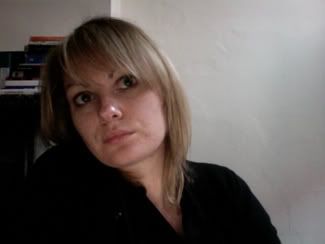|
Everything
Is OK
|

|
|
Everything
Is OK
|

|
 anne maree barry says hi anne maree barry says hi |
 affiliates affiliatesAnneMareeBarry Still Films Dark Light Paul Rowley Eoghan Kidney Alan Butler My Tweets My Vimeo Common Ground Mad decent Warrior One Cake |
 Tuesday, April 15, 2008 @ 3:19 PM Tuesday, April 15, 2008 @ 3:19 PMPeter Campus @ Albion, London
 Installation View - The Gift (2008) - ChanSchatz Installation View - The Gift (2008) - ChanSchatzI had not been to Albion before, it was a mission to get there - a tube journey to Sloane Square and then the 19 bus over Battersea Bridge, it was, however, well worth the effort. Albion claims that it leads an emerging trend - where art and design become indistinguishable. The two exhibitions currently on show - Peter Campus, and the husband and wife team ChanSchatz - compliment each other through colour and lack of colour and have a kind of off-beat relationship. I initially went to see Peter Campus' work, which whilst cold, was interactive and playful. I was surprised when I discovered the ChanSchatz's chaotic but very controlled kaleidescope wall-drawings and paintings. Peter Campus (1937) is one of the most important video artists of the 1970s. His early experimentation with studio shooting advanced (for the time) video equipment opened up a vast new set tools for artmaking, as well as pushing the conceptual envelope of video art and its potential - similar to Joan Jonas. A section of Double Vision (1971) was the only work I had seen of his and that was as a result of someone uploading a preview to YouTube. I was primarily interested in the methods Campus used to install work that I had only read about. Campus' recent work Predominance of Our Constructs (2007) is series of six video works made around the Ponquogue Bay in south eastern Long Island. The works are situated between the still images of photography and the duration of moving image/film. Using HD video he creates a still-frame of a landscape, where the movement occurs within the frame and not through the movement of the camera - something which I explore in my own work. The sound track recorded at the same time reveals what one cannot see. Campus places the viewer in an isolated position – the viewer is unaware of what exactly could be taking place - perhaps nothing? In contrast Campus' older works places the viewer in a privileged position – where their own image is part of the show. Stasis (1973) and Optical Sockets (1973) explore the formal sculptural qualities of projected video space using closed circuit video installations where the viewer experiences in real time their own image manipulated to produce unsettling camera effects - this all being cutting edge in the seventies. Optical Sockets (1973) was a personal favorite - omitting the fact that I could see my own reflection in the four video monitors, it evoked an experience of exploring the gallery space and the architectonic qualities of it through the interactivity of the video installation (the viewer walks between 4 video monitors on plinths and 4 closed circuit cameras). The precision and geometry of this installation did indeed demonstrate how such a piece challenges the relationship between artist, subject and viewer. This concept of the use of static camera's evokes big brother overtones as Campus reveals: "the camera was not directed by a person holding the camera but just put in a fixed position...i liked the idea of seeing something in front of the camera that wasn't so controlled, at least not by the artist." What is interesting is that Campus abandoned video art for twenty years, making only photographs until returning to video work in the 1990s. I wonder what he would think of a viewer celebrating his works in 2008 and documenting the works in low-res camera phone images? After all this interactivity, I walked blindly into Eric and Heather ChanSchatz's exhibition Together. I initially welcomed the warm colour of the work but suddenly I was left cold. Despite The Gift - which is a tactile piece(s) of work representing the larger painting behind it - the visual content was purely formal and graphical. I have since discovered that these works were created based on the artists' relationship with a range of communities. I believe that this facet of the work is hidden deeply in the pure form of the medium that they chose to work with. In comparison with Campus' use of available technology, and its tools, there is a sense of 'an experience' regarding his work. ChanSchatz may have good intentions but the work was emotionless. This slump did not last for long as I swiftly trekked to The Serpentine to see the Derek Jarman show, curated by Isaac Julien. The warmth returned like a hot whiskey sliding down my throat. Labels: albion, Anne Maree Barry, london, Peter Campus, technology, video-art |
|